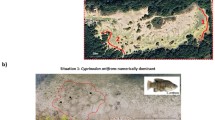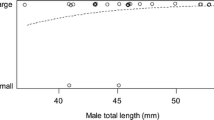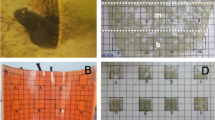Summary
Individual male fathead minnows spawn and guard eggs for a period of several weeks during a much longer total breeding season. Solitary males remain pale and lose both wet weight and dry weight throughout the nesting period, whereas competitive males, who defend nests adjacent to territorial rivals, turn dark and do not lose wet weight despite losing dry weight. A solitary male must contend only with territorial encroachment by females (potential mates and egg predators), but a competitive male must defend the nest against both males and females. A competitive male always attacks female intruders, whereas he initially displays to intruding males. Territorial rivals, though not egg predators, may try to usurp his nest. Successful competitive nest holders may appear more robust than their true condition and thereby prevent eviction by newly reproductive male intruders. Such newcomers preferentially attack residents in relatively poor condition and pale coloration.
Similar content being viewed by others
References
Branson BA (1962) Observations on the breeding tubercles of some Ozarkian minnows with notes on the barbels of Hybopsis. Copeia 1962:532–539
Dawkins R, Krebs JR (1978) Animal signals: Information or manipulation? In: Krebs JR, Davies NB (eds) Behavioural ecology. Sinauer, Sunderland, Massachusetts, pp 282–309
Goday D, Cochran M (1980) Dressing thin. How to look ten, twenty, up to thirty-five pounds thinner without losing an ounce. Simon and Schuster, New York, pp 31–32
Gross MR (1980) Sexual selection and the evolution of reproductive strategies in sunfishes (Lepomis: Centrarchidae). PhD dissertation, University of Utah, Salt Lake City
Gross MR, Nowell WA (1980) The reproductive biology of rock bass, Ambloplites rupestris (Centrarchidae). Copeia 1980:482–494
Hammerstein P (1981) The role of asymmetries in animal contests. Anim Behav 29:193–205
Isaak D (1961) The ecological life history of the fathead minnow, Pimephales promelas (Rafinesque). PhD dissertation, University of Minnesota, Minneapolis
Itzkowitz M (1978) Female choice in the pupfish (Cyprinodon variegatus). Behav Proc 3:1–8
Keenleyside MHA (1972) Intraspecific intrusions into nests of spawning longear sunfish (Pisces: Centrarchidae). Copeia 1972:272–278
Krebs JR (1977) The significance of song repertoires: the Beau Geste hypothesis. Anim Behav 25:475–478
Kynard BE (1978) Breeding behavior of a lacustrine population of threespine sticklebacks (Gasterosteus aculeatus L.). Behaviour 67:178–207
Lagler KF (1956) Freshwater fishery biology, 2nd edn. Brown, Dubuque
Markus HC (1934) Life history of the blackhead minnow (Pimephales promelas). Copeia 1934:116–122
Maynard Smith J (1974) The theory of games and the evolution of animal conflicts. J Theor Biol 47:209–222
Maynard Smith J, Parker GA (1976) The logic of asymmetric contests. Anim Behav 24:159–175
Maynard Smith J, Price GR (1973) The logic of animal conflict. Nature 246:15–18
McMillan VE, Smith RJF (1974) Agonistic and reproductive behaviour of the fathead minnow (Pimephales promelas Rafinesque). Z Tierpsychol 34:25–58
Parker GA (1974) Assessment strategy and the evolution of fighting behaviour. J Theor Biol 47:223–243
Parker GA, Rubenstein DI (1981) Role assessment, reserve strategy, and acquisition of information in asymmetric animal contests. Anim Behav 29:221–240
Ramaswami LS, Hasler AD (1955) Hormones and secondary sex characters in the fathead minnow, Hyborynchus. Physiol Zool 28:62–68
Sargent RC (1982) Territory quality, male quality, courtship intrusions, and female nest-choice in the threespine stickleback, Gasterosteus aculeatus. Anim Behav 30:364–374
Sargent RC, Gebler JB (1980) Effects of nest site concealment on hatching success, reproductive success, and paternal behavior of the threespine stickleback, Gasterosteus aculeatus. Behav Ecol Sociobiol 7:137–142
Smith DG, Reid FA (1979) Roles of the song-repertoire in red-winged blackbirds. Behav Ecol Sociobiol 5:279–290
Smith RJF (1974) Effects of 17-methyltestosterone on the dorsal pad and tubercles of fathead minnows (Pimephales promelas). Can J Zool 52:1031–1038
Smith RJF, Murphy BD (1974) Functional morphology of the dorsal pad in fathead minnows (Pimephales promelas Rafinesque). Trans Am Fish Soc 103:65–72
Sokal RR, Rohlf FJ (1981) Biometry, 2nd edn. Freeman, San Francisco
Trautman MB (1957) The fishes of Ohio. Ohio State University Press, Columbus
Turner JRG (1977) Butterfly mimicry: The genetical evolution of an adaptation. In: Hecht MK, Steere WC, Wallace B (eds) Evolutionary biology, vol 10. Plenum, New York, pp 163–206
Williams GC (1975) Sex and evolution. Princeton University Press, Princeton
Wynne-Edwards VC (1932) The breeding habits of the black-headed minnow (Pimephales promelas Raf.). Trans Am Fish Soc 62:382–383
Yasukawa K (1981) Song repertoires in the red-winged blackbird Ageliaus phoeniceus: a test of the Beau Geste hypothesis. Anim Behav 29:114–125
Author information
Authors and Affiliations
Rights and permissions
About this article
Cite this article
Unger, L.M. Nest defense by deceit in the fathead minnow, Pimephales promelas . Behav Ecol Sociobiol 13, 125–130 (1983). https://doi.org/10.1007/BF00293802
Received:
Accepted:
Issue Date:
DOI: https://doi.org/10.1007/BF00293802




